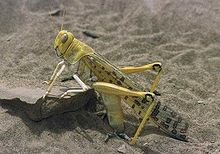
Back جراد الصحراء Arabic جراد الصحراء ARZ Schistocerca gregaria Byelorussian Llagosta del desert Catalan Schistocerca gregaria CEB Toliga DAG Wüstenheuschrecke German Kɔryɔm DIN Dezertakrido Esperanto Schistocerca gregaria Spanish
| Desert locust | |
|---|---|

| |
| A migratory phase adult laying eggs | |
| Scientific classification | |
| Domain: | Eukaryota |
| Kingdom: | Animalia |
| Phylum: | Arthropoda |
| Class: | Insecta |
| Order: | Orthoptera |
| Suborder: | Caelifera |
| Family: | Acrididae |
| Genus: | Schistocerca |
| Species: | S. gregaria
|
| Binomial name | |
| Schistocerca gregaria Forsskål, 1775
| |
| Synonyms | |
| |
The desert locust (Schistocerca gregaria[1][2][3]) is a species of locust, a periodically swarming, short-horned grasshopper in the family Acrididae. They are found primarily in the deserts and dry areas of northern and eastern Africa, Arabia, and southwest Asia. During population surge years, they may extend north into parts of Southern Europe, south into Eastern Africa, and east in northern India. The desert locust shows periodic changes in its body form and can change in response to environmental conditions, over several generations, from a solitary, shorter-winged, highly fecund, non-migratory form to a gregarious, long-winged, and migratory phase in which they may travel long distances into new areas. In some years, they may thus form locust plagues, invading new areas, where they may consume all vegetation including crops, and at other times, they may live unnoticed in small numbers.
During plague years, desert locusts can cause widespread damage to crops, as they are highly mobile and feed on large quantities of any kind of green vegetation, including crops, pasture, and fodder. A typical swarm can be made up of 150 million locusts per square kilometre (390,000,000 per square mile) and fly in the direction of the prevailing wind,[4] up to 150 kilometres (93 mi) in one day. Even a very small, 1-square-kilometre (0.39 sq mi) locust swarm can eat the same amount of food in a day as about 35,000 people.[5]
As an international transboundary pest that threatens agricultural production and livelihoods in many countries in Africa, the Near East, and southwest Asia, their populations have been routinely monitored through a collaborative effort between countries and the United Nations Food and Agriculture Organization (FAO) Desert Locust Information Service (DLIS), which provides global and national assessments, forecasts, and early warning to affected countries and the international community. The desert locust's migratory nature and capacity for rapid population growth present major challenges for control, particularly in remote semiarid areas, which characterize much of their range.[6]
Locusts differ from other grasshoppers in their ability to change from a solitary living form into gregarious, highly mobile, adult swarms and hopper bands, as their numbers and densities increase. They exist in different states known as recessions (with low and intermediate numbers), rising to local outbreaks and regional upsurges with increasingly high densities, to plagues consisting of numerous swarms. They have two to five generations per year. The desert locust risk increases with a one-to-two-year continuum of favourable weather (greater frequency of rains) and habitats that support population increases leading to upsurges and plagues.[7]
The desert locust is potentially the most dangerous of the locust pests because of the ability of swarms to fly rapidly across great distances. The major desert locust upsurge in 2004–05 caused significant crop losses in West Africa and diminished food security in the region. The 2019–2021 upsurge caused similar losses in northeast Africa, the Near East, and southwest Asia.
- ^ "species Schistocerca gregaria (Forskål, 1775): Orthoptera Species File". orthoptera.speciesfile.org. Retrieved 2020-02-16.
- ^ "Schistocerca gregaria (Desert locust) (Gryllus gregarius)". www.uniprot.org. Retrieved 2020-02-16.
- ^ Forsskål, Peter; Niebuhr, Carsten; Pre-1801 Imprint Collection (Library of Congress) DLC (1775). Descriptiones animalium, avium, amphibiorum, piscium, insectorum, vermium;. Ghent University. Hauniæ, ex officina Mölleri.
{{cite book}}: CS1 maint: numeric names: authors list (link) - ^ Draper, J. (1980). "The Direction of Desert Locust Migration". Journal of Animal Ecology. 49 (3): 959–974. doi:10.2307/4238. JSTOR 4238.
- ^ "FAO and partners stress urgent need on Desert Locust Response". www.fao.org. Retrieved 2020-02-16.
- ^ "No. 27: Economic and policy issues in Desert Locust management (S. Joffe, 1998)". www.fao.org. Retrieved 2020-02-16.
- ^ DLCEO-EA. "Desert Locust". dlco-ea.org. Archived from the original on 2020-02-16. Retrieved 2020-02-16.